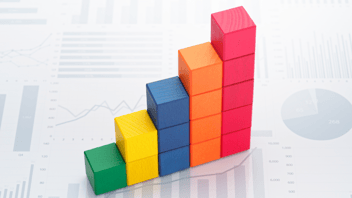

Published: June 15, 2022
As a teacher, your number one job is to provide your students with the knowledge and instruction they need to succeed in life. Unfortunately, this can be difficult to accomplish as school leaders tend to fixate on summative and standardized test scores rather than overall student growth. While this assessment data provides districts, administrators, and teachers with a global perspective of student performance, it lacks the granular detail required to track progress.
Using data in the Classroom
In data-driven instruction, teachers continuously gather and assess student learning data, using this information to improve upon their lesson plans and advance student progress. This creates a three-phase cycle of collection, analysis and intervention. Throughout the process, teachers are able to gather information on:
- Which students have mastered a skill and are ready to tackle a new topic.
- Which students need additional assistance to catch up to learning objectives.
- What works and what doesn't for each student and lesson.
Educators know that every classroom is unique, with students that have varying needs, abilities and levels of understanding. To ensure that every learner achieves their maximum potential, teachers can use data obtained from classroom assessments to build better curriculums and fine-tune their instruction for specific student needs.
Evaluating Educational Data Tools
As data reshapes the way students learn, education technology is changing the dynamics of classroom instruction. Learning management systems (LMSs) aim to collect and leverage student performance data to improve instruction and promote academic achievement. However, with so many solutions on the market, it can feel intimidating to choose the right tool for your school.
So, how do you evaluate what the right LMS is for your classroom? Here are a few capabilities you should look for:
- Simplify tasks like creating, distributing, and grading assignments.
- Track student engagement and assessment data to see who might need more attention.
- Perform data analysis to gauge the efficacy of student progress and instructional decisions.
- Create customizable progress reports to share with parents.
- Protect your student data with cybersecurity measures, such as encryption, to prevent hacks or leaks.
Protecting Your Data
While it's great to gather student learning data, educators and school leaders have a legal and ethical obligation to ensure it remains secure. For example, the Family Educational Rights and Privacy Act (FERPA) is a federal law that restricts who has access to student information, only allowing parents and educators to view these records. That means that schools could face legal consequences if data exposure were to occur.
To ensure that your school district remains FERPA-compliant, it's essential to vet your software vendor for cybersecurity standards. This is especially true for cloud-based solutions with student and parent portals. While access from anywhere and at any time offers convenience, you must ensure that data is protected during transit with strong privacy policies and encryption.
Setting Student Learning Goals
A common pitfall many educators fall into is gathering as much data as possible on student learning outcomes. This can create a mound of information that's impossible to parse. Instead, setting thoughtful milestones throughout the year can help you identify where adjustments need to be made. Consider focusing on the subject areas that are fundamental to student success and create learning objectives around these topics.
Gathering Student Progress Data
Teachers gather student progress information in a variety of ways, from low-stakes homework assignments to exams, test scores and attendance. For data-driven instruction to have the most impact on academic growth, it's important to collect information about learner activity and performance. Here are several classroom areas that are goldmines for data collection:
- Formative assessments like small quizzes and assignments.
- Student behavior observations.
- Projects, essays, and tests.
- Summative assessments like final exams.
- Standardized test scores.
- Cumulative records on student home life.
Evaluating Student Progress
Once you've collected enough information on student performance, it's time to evaluate progress on a granular level. Using data analysis tools, teachers can identify students that are falling behind, examine which instructional decisions worked and determine where there is room for improvement in the lesson plan. For example, evaluation results might indicate that some students aren't reaching math standards for their grade level. This might reveal underlying gaps in the curriculum and opportunities to optimize the lesson plan.
By using an LMS to track and analyze classroom data, teachers can present their findings to students, staff, parents and administrators. Visualization tools make it easy to create charts and graphs that clearly illustrate these insights, improving both comprehension and communication. Teachers can also use these features to share information and collaborate with each other, benefiting the entire educational community.
Providing Data-Driven Instruction
The final step in providing data-driven instruction is to turn your information into action. Using the data you've gathered and analyzed, you can identify skill deficiencies in your classroom and adapt your instructional decisions accordingly. In general, there are three different methods you can use to accomplish this:
Adjust whole-class instruction: To accommodate the needs of the broader class, you can alter instructional decisions for the entire group. From going over prior skill gaps to reteaching an entire lesson, sometimes these steps are necessary to ensure a strong grasp of the subject matter. Other times, you might just need to make a simple pace adjustment or create collaborative learning opportunities to encourage discussions and engagement.
Create groups based on student needs: In most cases, classroom data won't indicate uniform student needs. Using formative assessment data, teachers can divide students into several groups. That way, they can establish targeted instruction plans for each learning level. Alternatively, educators can create groups of students with different strengths to facilitate both social development and academic progress.
Develop personalized learning pathways: Addressing the whole class or grouping students together can be efficient, but teachers know that it's not always effective for every learner. Each student has unique strengths and weaknesses that become more apparent with data-driven instruction. To optimize student performance for individuals, teachers can create customized learning plans that set progress goals and address specific academic needs.
Dive Deeper Into How to Use Data in the Classroom
Data can be an invaluable tool for educators, enabling them to gain insights into student progress and adapt their lesson plans accordingly. However, that all depends on the systems you use.
At Schoolytics, we help teachers take their data-driven instruction to the next level with powerful education technology. Our student data platform centralizes information from multiple systems into a single place, with real-time dashboards and educational tools to help you optimize student performance while maximizing efficiency.
To learn more about effective data-driven instruction, sign up today, or request a demo.
Related Articles


Building a Learning Graph: The Bedrock of Holistic Student Analytics
True learning analytics requires far more than data from a single platform. While assessment...
